If there’s one dish that encapsulates the heart and soul of Filipino cuisine, it’s Adobo. With its rich history rooted in pre-colonial times and a taste that’s at once tangy, savory, and slightly sweet, Adobo is a cultural emblem passed down through generations. This Filipino Chicken Adobo recipe is not just about cooking; it’s about honoring a culinary legacy that has stood the test of time and geography, from the 7,000 islands of the Philippines to dining tables worldwide. Whether you’re a seasoned home cook or a curious foodie, join me in unraveling the secrets to creating an impeccable adobo that’s authentically Filipino.
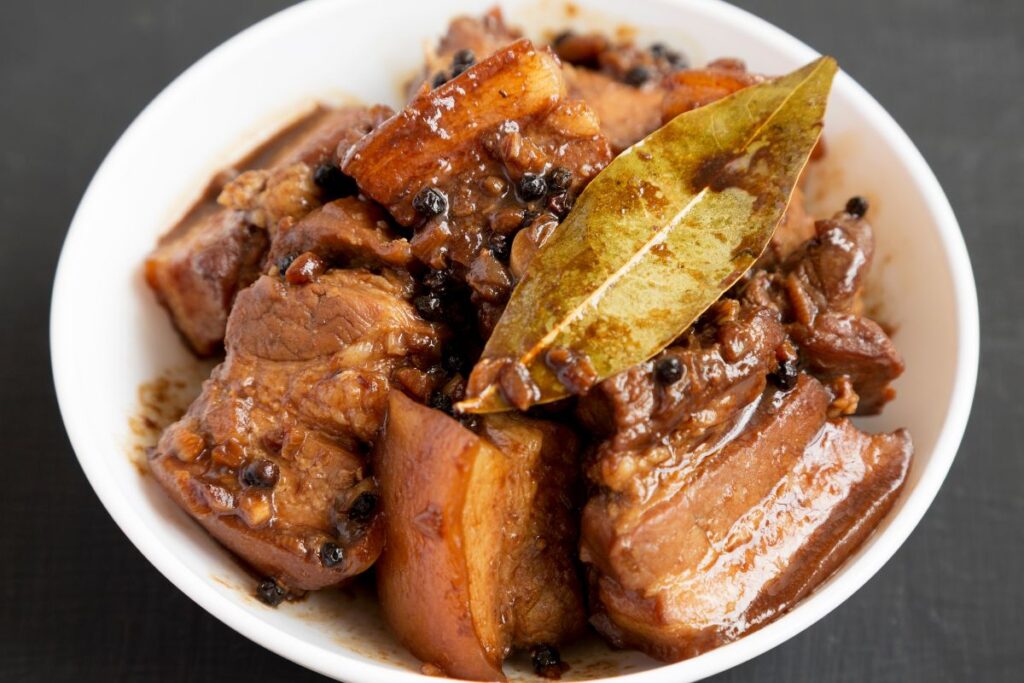
The Essence of Adobo
Filipino Chicken Adobo, often referred to simply as ‘Adobong Manok,’ is a classic comfort food featuring succulent pieces of chicken steeped in a marinade and then slow-cooked to infuse every morsel with its distinct flavor. The following recipe breaks down the process step-by-step and honors the peculiarities of regional adobo variations. Each household in the Philippines boasts its unique twist, setting the stage for endless interpretations.
A Taste of History
The term ‘adobo’ draws its roots from the Spanish phrase’ a la Adobo,’ which means ‘to marinate.’ This cooking method of preserving meat in vinegar and salt (or brine) was a Spaniard’s method of keeping food fresh without refrigeration. Upon their arrival in the Philippines in the 16th century, they found an island paradise already familiar with preserving meat using vinegar and salt, leading to a beautiful fusion of cultures.
In the contemporary context, Adobo isn’t just a dish; it’s a testament to the resilience and adaptability of Filipino culture, having survived centuries of colonial rule and emerged as a unifying culinary symbol.
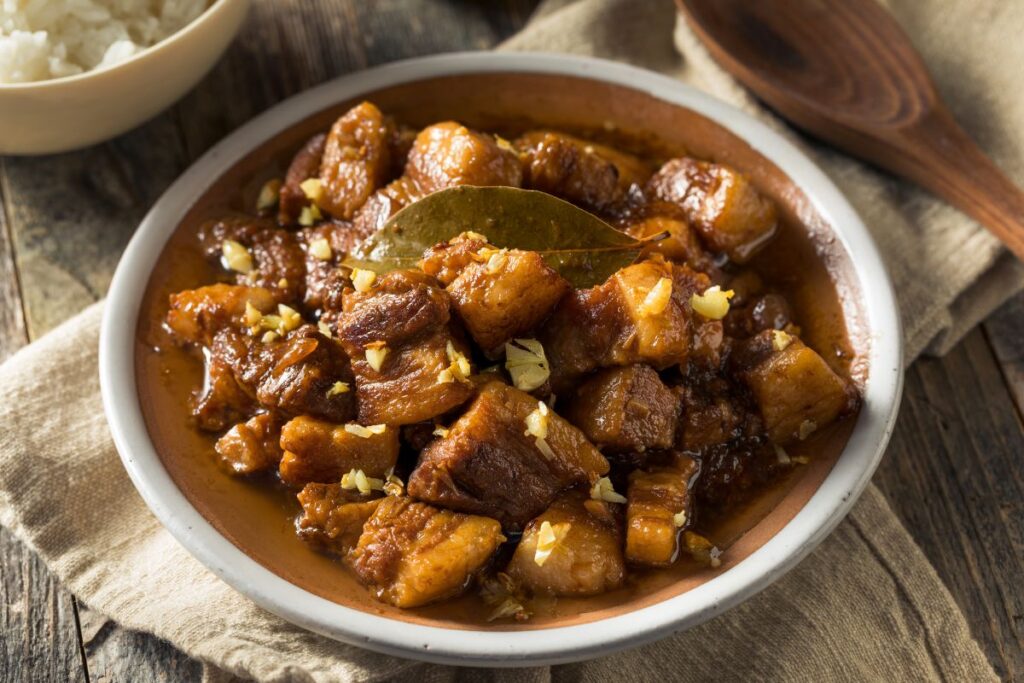
Essential Ingredients and Their Significance
Before you head to the kitchen, it’s essential to understand the foundational elements of Chicken Adobo.
- Chicken
In the rich tapestry of Filipino cuisine, chicken plays a versatile and pivotal role, particularly shining in this recipe. Chicken is not just any ingredient; it serves as the centerpiece, adeptly soaking up the complexities of the adobo sauce. This culinary process transforms it, making the chicken tender to the fork and deeply infused with flavors. The slow simmering method ensures that every fiber of the meat captures the essence of the sauce, resulting in a dish that is both hearty and bursting with taste.
- Vinegar
The sour component that defines the flavor profile of Adobo originates from vinegar, which is crucial not only for its taste but also for its preserving qualities. Indigenous Filipino vinegars, which include varieties made from coconut or sugarcane, are particularly valued for their ability to introduce unique nuances to the dish. These vinegars, with their distinct flavors, enhance the overall depth and complexity of the Adobo, making it a beloved dish in Filipino cuisine.
- Soy Sauce
A nod to the significant Chinese influence in Philippine culinary history, adding soy sauce to Adobo adds depth to the dish. It imparts a rich, dark hue that is visually appealing. It’s essential to be mindful of the type of soy sauce used, as its flavor profile can vary widely; some brands offer a sweeter taste, while others are known for their saltier, more umami-rich qualities. This variation can significantly affect the overall taste of the Adobo; choosing soy sauce is a crucial aspect of achieving the perfect balance of flavors.
- Aromatics
Onion, garlic, and often bay leaves are sautéed until golden and fragrant before the chicken joins the pot. These aromatics are the heart of Filipino cooking, marrying with the meat and sauce to create the Adobo’s signature aroma.
- Seasonings
Peppercorns are typically used whole to season the Adobo. Depending on taste preference, a sprinkle of brown sugar or a tiny nip of red chili can be added for complexity.
- Cooking Oil
Cooking oil can subtly influence the dish’s final taste when used for sautéing and frying before the sauce is added. Use a neutral oil to allow the flavors of the meat and aromatics to shine.
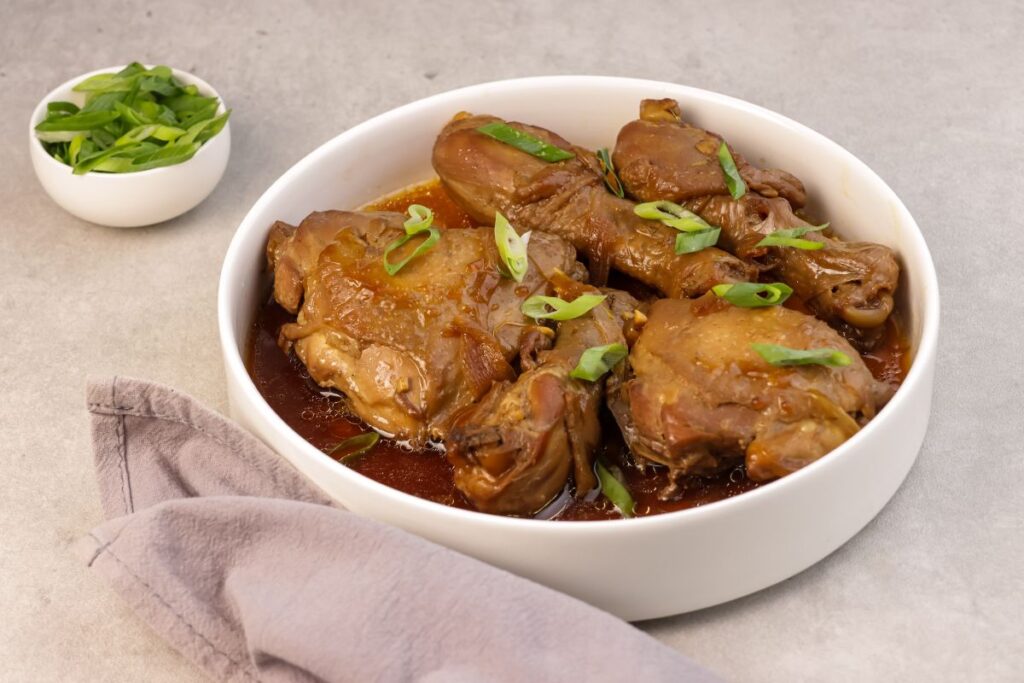
Cooking Up a Legend: The Step-by-Step Filipino Chicken Adobo Recipe
Now, immerse yourself in the art of adobo creation. This dish does not require an artist’s hand but rather a patient heart willing to slow down and savor the process.
Marinating the Chicken
- Begin by marinating your chicken pieces for at least an hour or overnight for depth of flavor. The longer, the better.
Sauteing the Aromatics
- Saute the garlic, onion, and bay leaves in a dash of oil until golden. This builds the base flavors of your Adobo.
Introducing the Chicken
- Add the marinated chicken to your pot or skillet, and let it turn golden before the next step.
Simmering with Love
- Pour in the vinegar and soy sauce. The sizzle and steam herald the marriage of ingredients. Lower the heat and simmer until the chicken is tender.
Caramelization Stage
- When most of the liquid has evaporated, allow the chicken to fry in the remaining sauce for a few minutes. This step creates a beautiful caramelized coat on the chicken, affectionately known as ‘adobo pula.’
The Final Salute
- Plate your Chicken Adobo, and with pride, enhance the dish with the aromatics and reduced sauce from the pan.
When executed with care, this reasonably straightforward method yields a complexity of taste that is nothing short of magical.
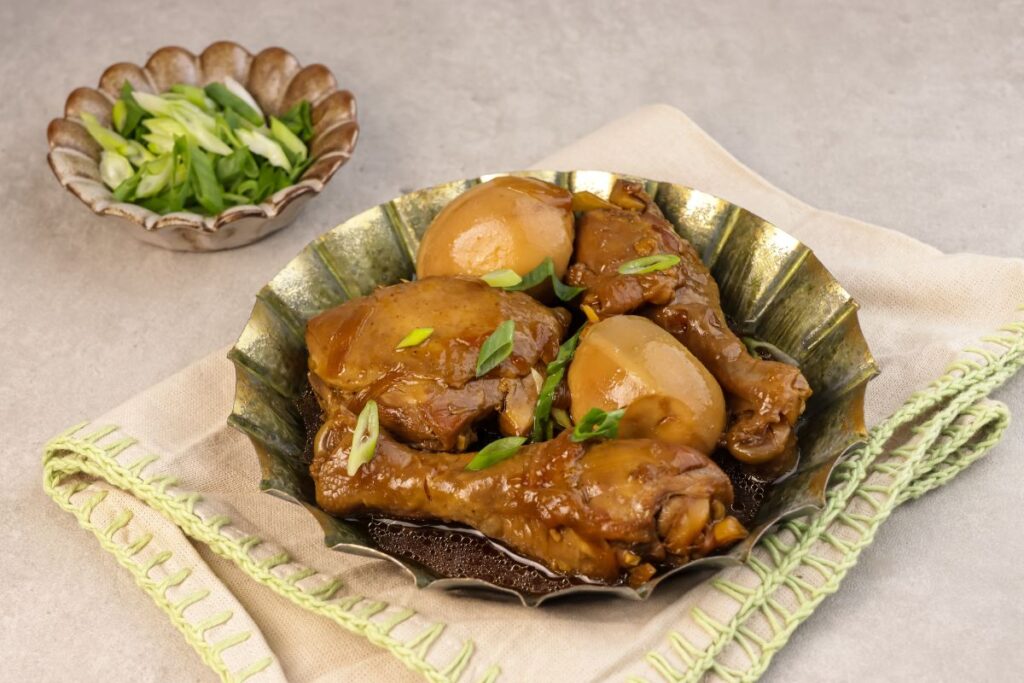
Tips and Tricks for Filipino Chicken Adobo Recipe
Adobo doesn’t play by the rules, and it loves a bit of experimentation. Here are insights to help you ace your adobo game.
Marinating Matters
The longer you marinate, the deeper the flavors penetrate. In many households, marinating Adobo for a day is a tradition, not a suggestion.
Choice of Meat
While this recipe focuses on chicken, Adobo is versatile. It can be used with pork, beef, and even seafood. Each has its unique flavor profile and preferred cooking time.
Serve with Style
Adobo is typically enjoyed with white rice, which acts as a canvas for the saucy masterpiece. To balance the richness of the Adobo, add a side of refreshing green salad or steamed veggies.
Storing and Serving Leftovers
Adobo’s flavor only improves over time. Store leftovers in the refrigerator and reheat portions as needed, finding that the dish tastes even better the next day.
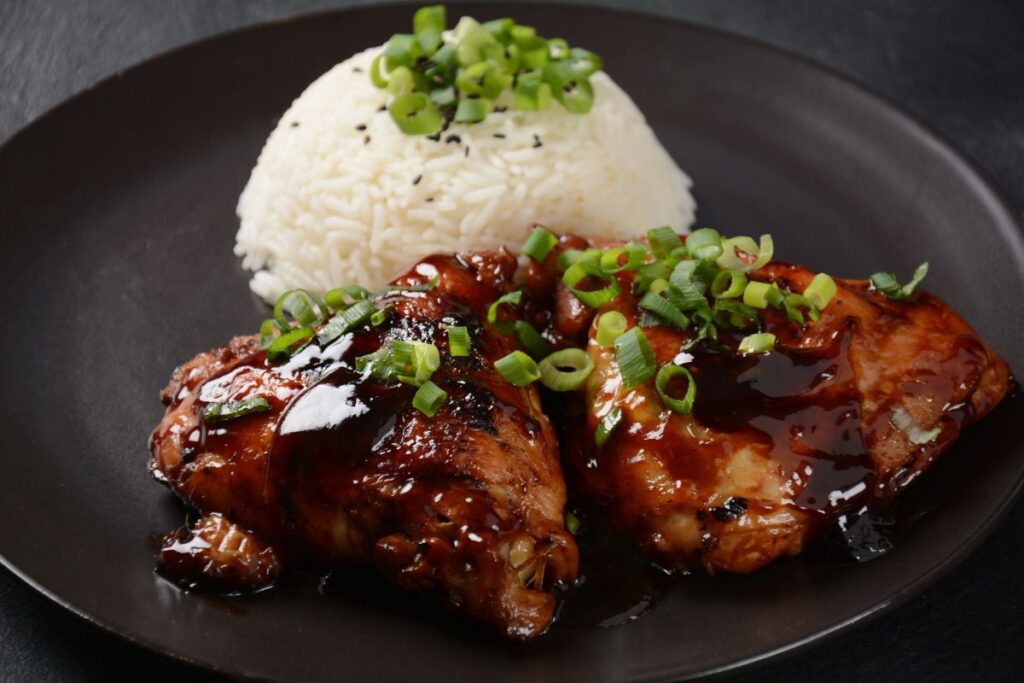
Uncovering the Health Benefits of Chicken Adobo
While Adobo isn’t typically considered a ‘health food,’ some of its main ingredients offer surprising benefits.
Garlic – More than Just Flavor
Garlic is known for its immune-boosting properties and can even help reduce blood pressure levels, adding a healthful element to your Adobo.
Protein Power
Chicken is a lean meat packed with protein. It’s a building block for your body, aiding in muscle growth and repair.
Vinegar’s Virtues
Vinegar, due to its acidic nature, can be used in Adobo to help manage blood sugar levels and enhance digestion.
With a dash of awareness, you can savor your Adobo with health in mind.
Pairing Perfection and Serving Suggestions
What good is an adobo without a supporting cast that elevates its taste?
Riding the Wave: Beverages and Sides
Consider pairing your Adobo with a cold glass of sweet iced tea or a malty, full-bodied beer. For sides, the choices are as varied as they are boundless. Steamed jasmine rice, creamy mashed potatoes, or even a basket of sweet buns can delightfully complement your Adobo.
Light-Dark Dance of Flavors
A light dessert such as leche flan, a caramel custard, can provide a sweet contrast to the richness of the Adobo. For a darker side, a slice of decadent chocolate cake can conclude your meal in a crescendo of taste.
Stirring Stories: Personal and Cultural Links to Your Adobo Adventure
Every dish tells a story, which adds flavor to the dish.
Family Traditions
Share a memory of adobo nights with loved ones, where stories were told, and laughter was shared over a pot of simmering goodness.
Cultural Exchanges
Relive the experience of sharing Adobo with friends from other cultures and watching them fall in love with the dish and its heritage.
Culinary Adventures
This is a detailed culinary exploration of the nooks and crannies of the Philippines, where you will discover the regional twists on the beloved adobo recipe.
Global Tastebuds
Reflect on how Adobo has become a part of international palates, a bridge between communities, and a point of pride for Filipinos everywhere.
With these intimate narratives, you invite readers to create a meal and become part of a larger, cultural conversation.
By unwrapping the layers of tradition and taste and turning the pages of a recipe that is much more than the sum of its parts, we chart a course through the incredible world of Filipino cuisine. This is a celebration of filipino filipino chicken adobo recipe recipe — a dish as rich in history as it is in flavor and a tribute to the larders of those who have made it a part of their story. Sarap! (That’s Filipino for ‘It’s Delish!’)
Indulge in this Filipinofilipino chicken adobo recipe recipe as a mark of respect for a culinary trajectory etched in the collective Filipino consciousness. Each step is a pulse of the community, and each taste echoes history. May your Adobo bring you warmth, joy, and a connection to a culture as vibrant as the dish itself.
Other Notable Filipino Dishes
Aside from filipino chicken adobo recipe, many other delicious Filipino dishes are worth exploring. Some notable ones include:
- Sinigang: a sour and savory soup made with tamarind broth and various vegetables and proteins.
- Lechon is a roasted pig that is served during special occasions or celebrations.
- Lumpia: crispy fried spring rolls filled with vegetables, meat, and sometimes shrimp.
- Kare-Kare: a rich and creamy oxtail stew made with peanut sauce and various vegetables.
Filipino Chicken Adobo Recipe
Course: DinnerCuisine: PhilippinesDifficulty: Easy6
servings5
minutes42
minutes345
kcalChicken adobo is a classic Filipino dish loved by many. It is flavorful and savory, made with simple ingredients, and easy to prepare. This article will explore the traditional Filipino chicken adobo recipe and learn how to make it at home.
Ingredients
1 kg chicken, cut into pieces
1/2 cup soy sauce
1/2 cup vinegar
Four cloves of garlic, minced
One onion, chopped
One teaspoon of black peppercorns
Three bay leaves
One tablespoon of cooking oil
Directions
- In a large bowl, marinate the chicken pieces with soy sauce, vinegar, minced garlic, and black peppercorns for at least 30 minutes or overnight for a more intense flavor.
- Heat the cooking oil in a large pan over medium heat. Add the chopped onion and sauté until translucent.
- Add the marinated chicken to the pan, along with the marinade. Bring it to a boil, then reduce the heat to low and let it simmer for about 40-45 minutes or until the chicken is tender and fully cooked.
- Add the bay leaves to the pan and simmer for 5 minutes.
- Remove the bay leaves before serving.
- Serve the chicken adobo hot with steamed rice.
Recipe Video
For more delicious homemade cook recipes, check out here-
- How to Cook Homemade Dauphinoise Potato Recipe
- How to Cook Creamy White Bean Chicken Chili Recipe
- How to Cook Baked Gnocchi Alfredo Recipe
- How to Cook Gochujang Carbonara Recipe
- How to Cook One-Pot Creamy Lemon Chicken & Asparagus Pasta
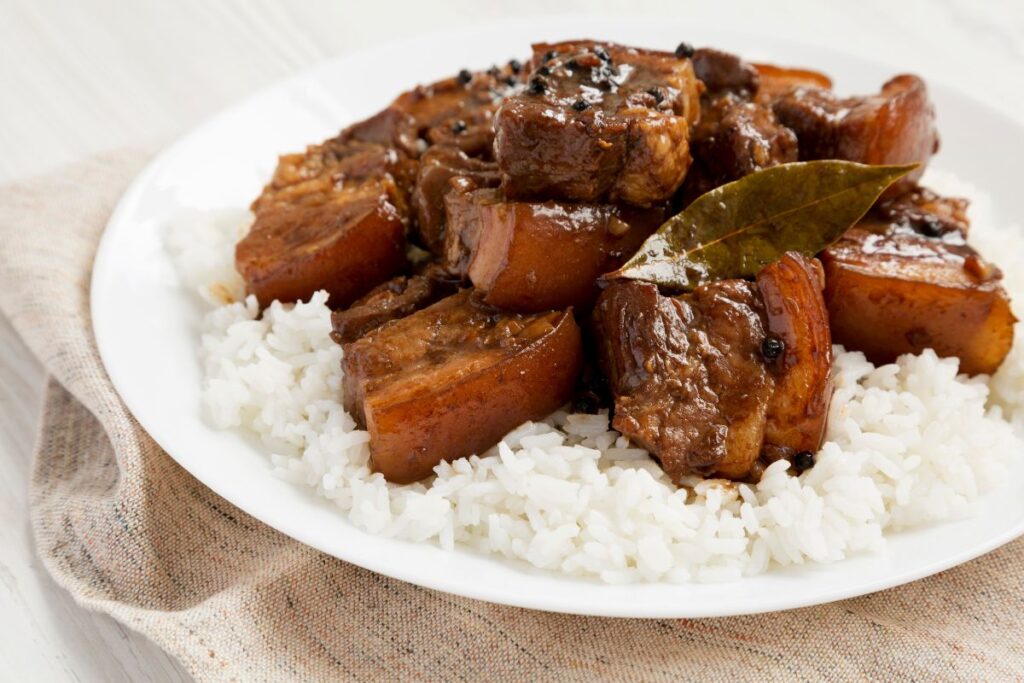
Conclusion
In the tapestry of Filipino cuisine, filipino chicken adobo recipe stands out as a signature dish, embodying the Philippines’ warmth, richness, and diversity. This recipe, more than just a cooking method, represents a confluence of history, culture, and familial bonds, seasoned with memories and shared over countless tables across the globe. Its simplicity belies the depth of its flavor, a testament to the idea that the most profound experiences often come from humble beginnings. Whether you’re a seasoned chef or a curious newcomer, making filipino chicken adobo recipe invites you into an ongoing narrative of tradition and innovation. It’s a dish that comforts, connects, and continues to evolve, much like the vibrant community that champions it. Let this filipino chicken adobo recipe not just be a meal but an exploration of the rich cultural fabric from which it originates, an edible invitation to appreciate the universal language of good food shared amongst friends and family.
Reference
My Mom’s Filipino Chicken Adobo Is So Good, I Make It for Dinner Every Sunday
Frequently Asked Questions about Filipino Chicken Adobo
Can I use boneless chicken for Adobo?
Yes, boneless chicken can be used for Adobo, though traditionally, bone-in pieces are preferred for their flavor. Cooking time may need to be adjusted, as boneless meat tends to cook faster.
How long should I marinate the chicken?
While a minimum of an hour is sufficient for the flavors to start melding, marinating the chicken overnight in the refrigerator will significantly enhance the depth and richness of the Adobo.
Is it possible to make Adobo without soy sauce?
Absolutely! A soy sauce-free version is “Adobong Puti,” which uses vinegar, salt (or fish sauce), and spices. This variant caters to those who avoid soy or aim for a different taste profile.
Can Adobo be made vegetarian?
Yes, vegetarian adaptations of Adobo use tofu, mushrooms, or a mix of vegetables as the main ingredients. The key is maintaining the signature balance of vinegar, soy sauce (or an alternative like coconut amino for a soy-free version), and spices.
How do I store leftover Adobo, and how long does it last?
Leftover Adobo can be stored in the refrigerator for 3-5 days. As the flavors develop, it is known to taste better the next day. For best results, ensure it’s stored in airtight containers.
Is Filipino filipino chicken adobo recipe gluten-free?
Traditional Adobo can be made gluten-free by substituting gluten-free soy sauce for regular soy sauce. Always check labels to ensure compliance with a gluten-free diet.





